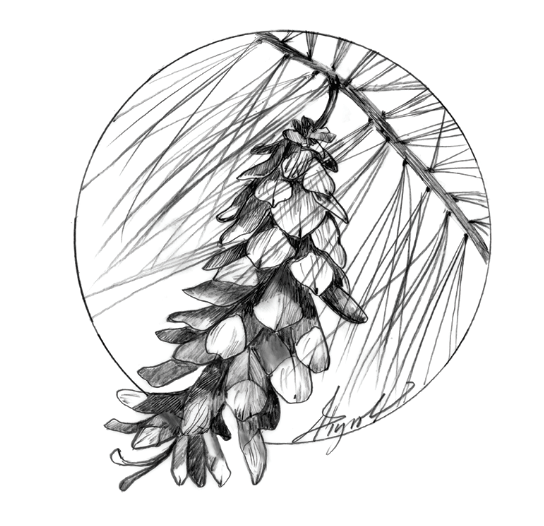 My yard is full of Eastern white pine trees, and every three years or so, it is full of pine cones. This is one of those years. Pine cones have fallen all over the yard, the sidewalk, the driveway. The neighborhood wildlife seem pleased by this bounty. A resident gray squirrel has made a fallen log in my yard its snack site. Pine cone fragments are neatly arranged in a circle around the squirrel’s perch.
My yard is full of Eastern white pine trees, and every three years or so, it is full of pine cones. This is one of those years. Pine cones have fallen all over the yard, the sidewalk, the driveway. The neighborhood wildlife seem pleased by this bounty. A resident gray squirrel has made a fallen log in my yard its snack site. Pine cone fragments are neatly arranged in a circle around the squirrel’s perch.
Synchronized conifer mast cycle—or the yearly variation in the number of cones produced— vary by species. For Eastern white pines, cone “mast years,”—when the trees produce a large number of cones—occur every few years. Mast years benefit the trees through a phenomenon ecologists call “predator swamping.” When multiple trees produce masses of seeds all at once, there are more seeds than predators can eat, and some of these seeds therefore have a chance at germinating. Non-mast years give trees time to recover their energetic reserves, and also to starve out seed predators. By the time the next mast year arrives, the predator population—having diminished with less available food—will be relatively sparse.
A white pine tree produces both male and female cones. The cones we find on the ground are female. Male cones look like miniature versions of the female cones and release yellow pollen during spring. You’ve likely noticed this pollen coating your driveway – and, perhaps, causing sneezing fits. Conifers are wind-pollinated, so the powder-like pollen grains reach female cones on the breeze. Pollen grains that land inside the developing female cone fertilize an embryo there, and that embryo becomes a seed.
After seeds have developed, pine cones open in dry weather, and seeds are dispersed by wind. If you hold a freshly dropped female cone with the pointed end facing up, you’ll see the seeds sitting close to the stem, just above the pine cone scales, those individual woody pieces that give the cone its shape. A white pine seed looks a bit like a maple seed lodged inside the cone, with a papery tail extending the length of the scale. This tail acts like a kite. During rainy weather, the moisture-sensitive scales of a pine cone close to keep the seeds dry and protect them from rot.
Pine seeds contain plentiful nutrients and protein, which are necessary for a new pine tree to get its start – and also a prize for animals seeking calories. Small mammals collect seeds during autumn and cache them for winter snacking. Some seed predators, such as red squirrels, cache the whole cones. Many bird species are frequent pine seed eaters. Red-breasted nuthatches cache pine seeds underneath tree bark, while red- and white-winged crossbills have specialized beaks that allow them to pick seeds from the cones. Gregarious pine siskins are also frequent conifer seed eaters and during winter may appear in large flocks in areas with abundant pine cones.
These seed collectors can help propagate the next generation of pines. Squirrels and nuthatches forget some of their caches, giving these seeds a chance to grow into trees. Seeds cached by squirrels are already buried in the soil, offering them a head start toward growth.
Eastern white pine is one of the most common pines in the Northeast. White pines grow fast and well on old agricultural land, giving this species the nickname of “old field pine” or “pasture pine.” However, there are several other conifer species in the region that have their own masting cycles.
If you live in northern New England or New York, you may have white or red spruce, which drop their cones less than a year after the cone starts to develop. Jack pines may take more than a decade to drop cones. Pitch pines, found across much of the East Coast, can take 10 years to drop cones, but these won’t open until the heat-sensitive cones have experienced fire.
Rather than gathering and disposing of the pine cones that have dropped in your field or yard, consider leaving them for wildlife. If you must clear the yard, perhaps leave some cones in a pile for the resident squirrels, mice, and birds. Keep an eye on the pile – the pine cones may soon be stripped of their seeds.
Jenna O’del is a biologist and science writer based in Rhode Island. Illustration by Adelaide Murphy Tyrol. The Outside Story is assigned and edited by Northern Woodlands magazine and sponsored by the Wellborn Ecology Fund of the New Hampshire Charitable Foundation: nhcf.org.




